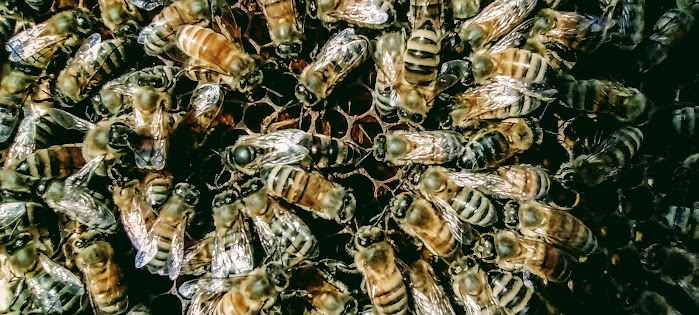A Warm April Saturday- Going Through Hives
Two hives- one pulled apart- in my neighbor's yard, who generously lets me keep them there, at the foot of an ancient pear tree, which my hives have many times swarmed to in the last 30 years, and I drop them right there into a box. I can't recall how many- 20 or 30?
But here are two left, and I want to do what I can to make sure they make it. Over the winter, the sibling betbeween them (now moved out to my long stack of empty boxes), died. But these two seem to be doing pretty well.
Frames at the bottom of Spring hives tend to look like the below-if you keep bees you've seen this a bunch. Empty, more or less clean and polished, and a great place for a queen to lay if it were warm enough. Which it isn't early on. But normally, I reverse boxes about now- put the active ones down, and one's like this up on top. The theory being, that it saves the bees some work, though, like about everything in beekeeping- even that's heavy in wishful thinking, and low on actual knowledge. I doubt, frankly, that is makes a wit of difference. Maybe damage. Bees likely know a lot better than we do as to where they want their queen to lay eggs.
Above the bottom box- in the two above at this time of year- there is a lot of activity. A lot of brood, pollen, and nectar, stored in a hodgepodge way with lots of bees on it all. For me- this is a sign of impending swarms- hives that have it together, are strong, with a strong queen. In earlier years, I was pretty happy to see this- a strong hive after the winter- but with experience, one realizes that these are the hives that will swarm without warning, or crash, or whatever- but in general, not fulfill what one would think is there potential. Bees aren't wired to just hang out in one place- like all of us- they want to go forth and multiply, so any effort to make them happy where they are, is counter to their programming. To survive, in the long run, they constantly need new queens, with a wide variety of matings, and only then would we hope to see them survive.
But a beekeeper wants them to stay in their box, fool them, take their honey, all of that.
In this pic, the beautiful unmarked queen is moving up and in the center. I marked her yellow after this pic, to indicate the year I found her. This one is a powerhouse- a full three supers mostly full of brood.
Coser up- she's to the right...
And here she is flipping around to the other side of the frame. They move quick. I've made the same mistake many times, isolating a queen on a frame, separating the frame from the others, turning my back, and then not finding here again. Because-she got off the frame,- and walked along the side of the box to another frame- because she's frantic and wants to move I think- but one loses her in the crowd. Best is to get her totally isolated- but that's hard to do.
If you're starting out, I'd advise you to mark your queens. No queen unmarked. I'd say that's one of the smartest things I ever started doing. It's a lot about finding your queen faster- but mostly about knowing if the queen you are seeing is the one that was there the last time you inspected. If you marked here, and then see no mark, then you know she's been superceded (a good thing), though later, it suggests a swarm happened on your watch (not a good thing). Yellow is the best color- easiest to see, but I keep all the colors for the years and try to adhere to them. I use the tool below- but I just pick out the queen and stick here in and don't use the trap part- its way too dangerous for the queen. You can see her in the catcher just above my thumb.
This is how I've managed swarms for three or four or more years- and it works. There are parts I don't get- like how to allow for straight supercedure- but it's a powerful method to keep hives with their populations intact. As with any method, its all about ensuring there aren't queen cells- but when the queen is confined, it becomes a lot easier.









Comments
Post a Comment